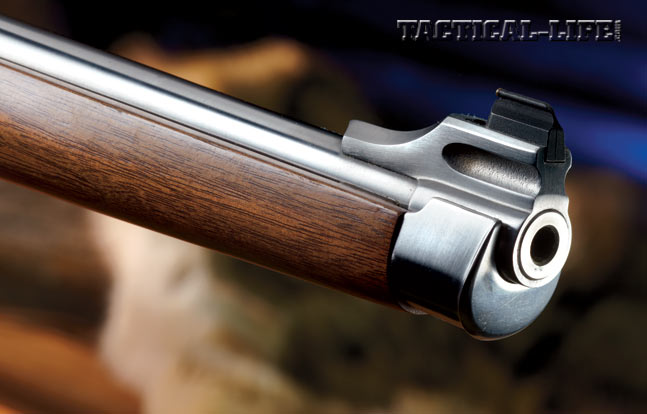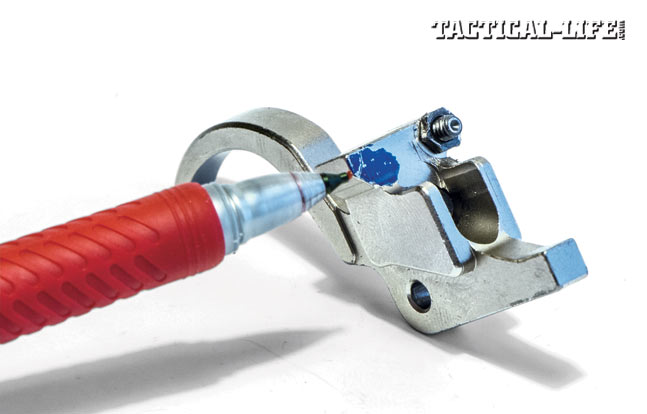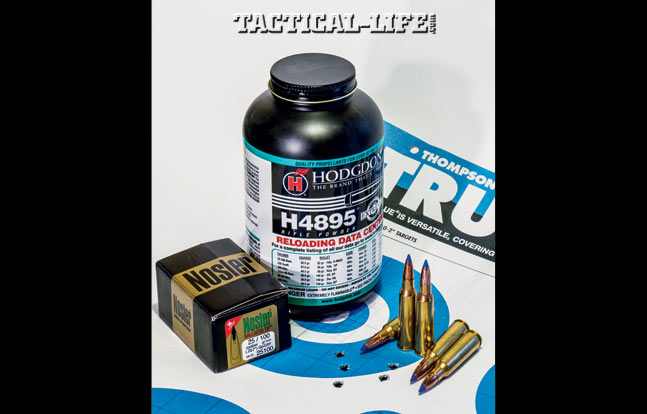There’s no question the Ruger M77 is one of the most successful bolt-action hunting rifles of all time. Ruger wisely included features like a three-position safety and a Mauser-like claw extractor. But, Ruger was also smart in that it sometimes offered the M77 chambered for classic cartridges and in some not-so-usual configurations. One of the best-looking Ruger M77s ever produced was the RSI, or International as it was called, with its full-length Mannlicher stock.
Ruger offered the M77 RSI from 1986 until 2010. Having grown up shooting mountain-style muzzleloading rifles with full-length stocks, I was always drawn to the RSI and purchased the first one I found. It was chambered in .243 Winchester. It shot reasonably well, but its point of impact changed with the weather. If the temperature dropped, if it rained or if it got hot, the point of impact would wander. The same could also be expected if you fired more than two or three shots; the barrel got hot and bullets sprayed the target.
I shot a few deer with the rifle and in a moment of weakness, while lusting for a different rifle that would not let its bullets stray, I sold it. Funny thing, within a year I purchased another M77 RSI. Same story. Still, I hunted with the rifle a lot and held onto it right up until the time my military career took me to Idaho. I figured I’d need a farther-reaching rifle that I could count on, so I sold that Ruger M77 RSI, too.
Advertisement — Continue Reading Below
Well, the third time’s the charm. Maybe?
Continue Reading: Custom Ruger M77 RSI .250 Savage: Classic Rifle Reborn | Gun Review

Another Try
Advertisement — Continue Reading Below
I couldn’t stop lusting for another of those full-stock M77s, and when a friend who collects Rugers told me he had a limited-edition, stainless steel M77 RSI, and that it was chambered for the .250 Savage, I could not resist. I also thought that maybe after about 20 years of tinkering with rifles that I’d learned a thing or two about fixing them, and that I could correct the wandering point-of-impact problems inherent to the M77 RSI.
“The Timney trigger for the Ruger Mk II action is easy enough to install, but it requires that you file some material away from the trigger where it interacts with the safety…”
You see, the problem with these rifles is the interaction between the nose cap, the stock and the barrel. The tip of the stock is sandwiched between the nose cap and the barrel. To complicate the problem, the nose cap is screwed into a nut locked inside the stock, and the nose cap surrounds the band at the end of the barrel. This means, as the barrel heats up, it has to work against the stock by virtue of the attachment process. The wood-to-metal contact also detracts from its accuracy.
This rifle’s first trip to the range showed it had the same problems of my two previous RSIs. Factory Remington ammo grouped five shots into an unacceptable 3-inch cluster, and my best .250 Savage handload was not much better. So I went to work.
Advertisement — Continue Reading Below
First, I relieved the stock all along the barrel, from the action to the end of the forend. Then I also relieved some wood around where the recoil lug fits into the stock and at the very tip where the barrel band matches up with the stock. Using Brownells Acraglas, both of these points were lightly bedded. This helped lock the barreled action into the stock, but I also needed to correct the issue with the nose cap pushing against the barrel band. To do this I took a flat file and worked the inside of the nose cap at the tips until there was a gap between it and the barrel band. Now, when assembled, there’s no contact between the nose cap and the barrel.
While I had the rifle apart I thought it would be a good idea to address the trigger. After all, the trigger is the most important part of a shooter’s interface with the rifle, and the trigger on the M77 RSI was a bit heavy at 4.8 pounds, and it had some creep, too. The simple answer was to install a Timney trigger, so I ordered one and proceeded to screw it up during installation.
The Timney trigger for the Ruger Mk II action is easy enough to install, but it requires that you file some material away from the trigger where it interacts with the safety. I must have been dreaming about big bucks or beautiful women while I was filing away because I cut too much. This meant I had to order another trigger. Instead, I just shipped the barreled action off to Timney and let the experts perform the installation. In less than a week it was back, and the trigger pull was crisp and clean and right at 2 pounds.
Advertisement — Continue Reading Below
Continue Reading: Custom Ruger M77 RSI .250 Savage: Classic Rifle Reborn | Gun Review

Leupold Glass
I assembled the rifle and was eagerly anticipating stepping out to the range when I realized I didn’t have an ideal riflescope for this compact rifle. I didn’t want a big 3-9x40mm scope; I wanted a low-powered variable with a thick and easy-to-see reticle. A scope like this would perfectly compliment the quick handling characteristics of the rifle and make it right at home in the deer woods where I intended to use it.
Advertisement — Continue Reading Below
“Think about it, I’d wanted one of these rifles, one that would shoot consistently, for more than 20 years…”
I was just about to order a new Leupold when I realized I had a Tactical version of Leupold’s 1.5-5X 24mm VX-3 on hand. It was fitted with the company’s Special Purpose mil-based reticle. I boxed the scope up and sent it off to the engineers at the Leupold Custom Shop with instructions for them to install a German No. 4 reticle and the company’s excellent CDS turret system.
For those not familiar with the CDS system, it is an exposed, vertical adjustment turret pre-marked to match the trajectory of your ammunition. To make all this work, you have to provide Leupold with the ballistic data for your load, and the company will convert that data into a custom dial to fit your CDS scope. The conversion costs about $100, and you can have multiple dials to work with multiple loads. My load of choice for the .250 Savage is 35 grains of H4895 behind a 100-grain Nosler Ballistic Tip bullet, and it generates an average muzzle velocity of 2,832 fps out of the Ruger’s 18-inch barrel. That’s the data I provided Leupold.
Impatiently, I waited the 11 days it took the scope to go to Beaverton, Oregon, and return. When it came back home, I mounted it in the standard, stainless Ruger rings that came with the rifle and stepped outside to see how my lightly customized and hopefully corrected classic rifle would perform. Think about it, I’d wanted one of these rifles, one that would shoot consistently, for more than 20 years.
Advertisement — Continue Reading Below
Continue Reading: Custom Ruger M77 RSI .250 Savage: Classic Rifle Reborn | Gun Review

Enhanced!
The first post-customization, five-shot group measured just a shade over 1 inch. Not bad, I thought. Two more five-shot groups produced similar results. There were no flyers, and the point of impact did not wander all over the target. I went back into my house smiling and decided to wait for different weather to see if I had corrected that problem, too. So far, neither moisture nor temperature has been found to move the point of impact at 100 yards more than a half-inch or so.
Advertisement — Continue Reading Below
“There’s nothing like a full-stocked rifle to generate envy around the campfire.”
The other aspect of the rifle in its customized state is the CDS scope. Now, if I need to shoot at 200, 250 or even 300 yards, I simply turn the exposed elevation dial to 2X, 2.5X or 3X and hold dead on. Sure, really savvy long-range shooters like to click in the exact number of clicks based on range and other atmospheric conditions, but unless you do this on a regular basis, it can get confusing when you’re looking at a big buck. The Leupold CDS system just simplifies the process.
If you have one of these Ruger RSIs that you have relegated to the gun safe due to its inability to hold its zero with weather changes or even beyond a few shots, or if you have always lusted after one but were afraid to take the plunge for fear that what you have heard about their accuracy issues was true. Maybe it’s time to drag that rifle out or to go ahead and lay down the cash for the one you always wanted. Ruger is not making the RSI versions anymore, but for less than $200 and some elbow grease, you can fix the bedding and nose cap issues and even install a fine trigger.
There’s nothing like a full-stocked rifle to generate envy around the campfire. If the rifle of your dreams is a Ruger M77 RSI, you can have a good-looking rifle and make it a real shooter, too.
Advertisement — Continue Reading Below
I’m hoping a nice buck steps out this fall and says, “Man, that sure is a good-looking rifle you got there.” If one does, it will be the last thing he ever says, even if he’s all the way out there at 300 yards.
EDITOR’S NOTE: Ruger has released a limited run of M77 RSIs exclusive to Lipsey’s. In addition to various centerfire options, rimfire versions are also available. For more, visit lipseys.com or call 225-755-1333.
FOR MORE INFORMATION:
Ruger
ruger.com
Leupold
leupold.com; 800-538-7653
Timney Triggers
timneytriggers.com; 623-223-1111






































